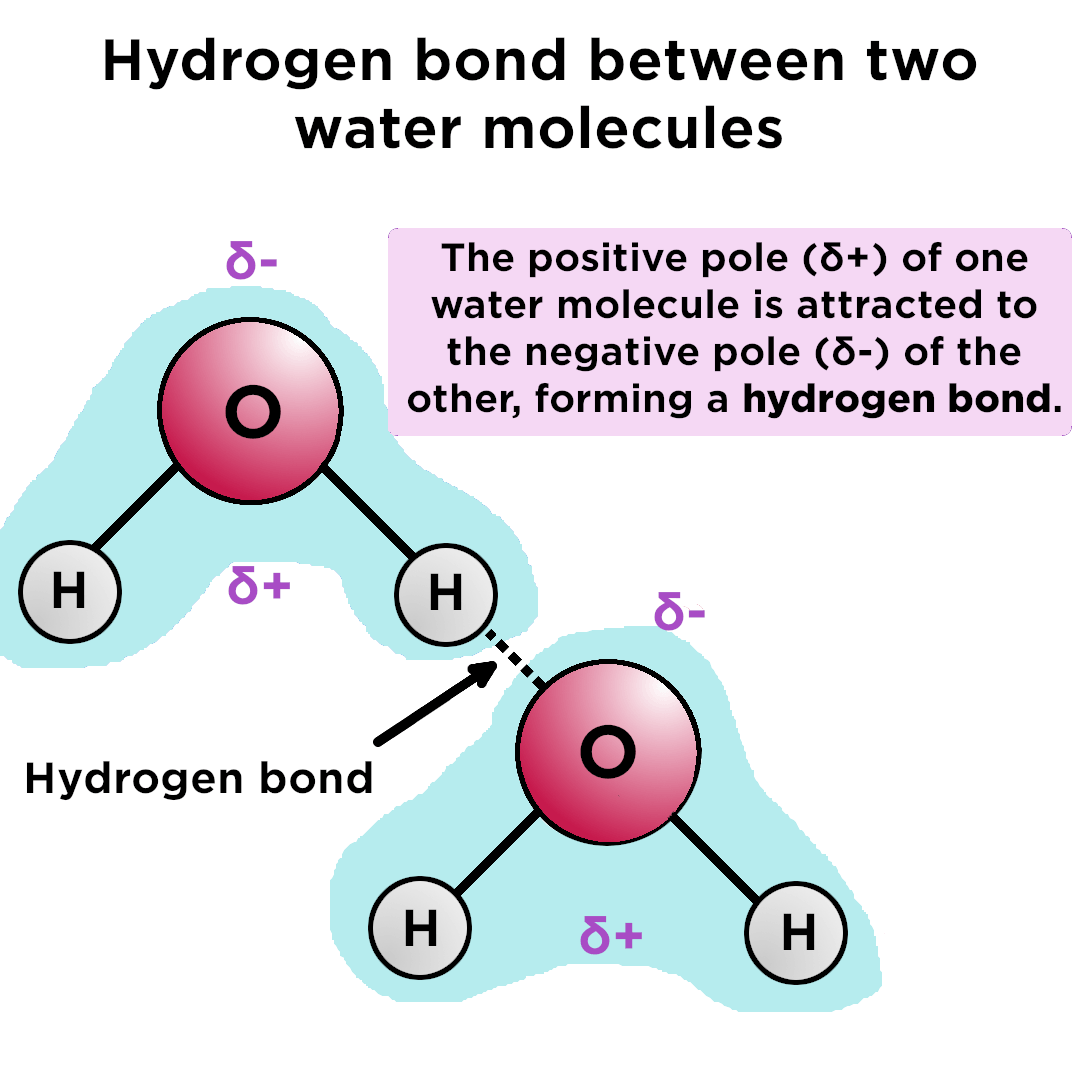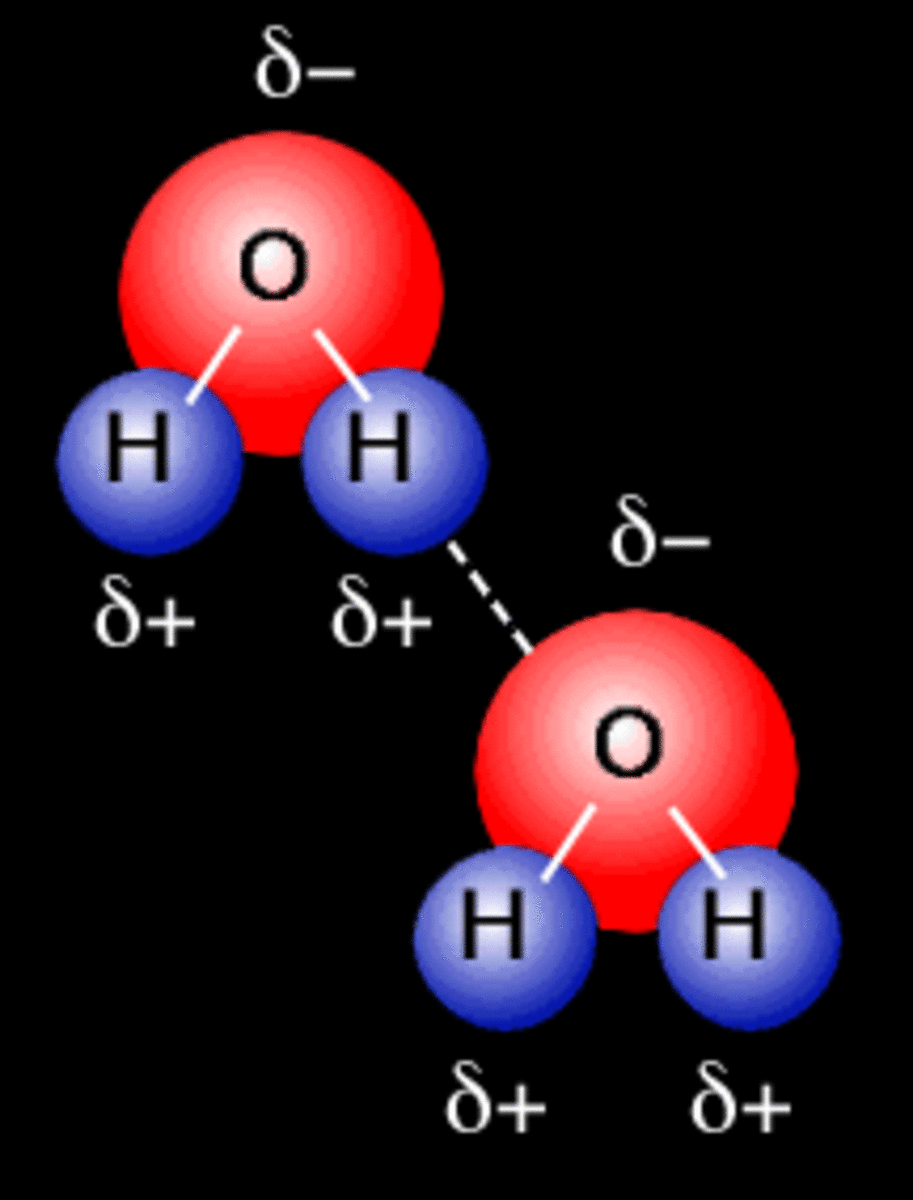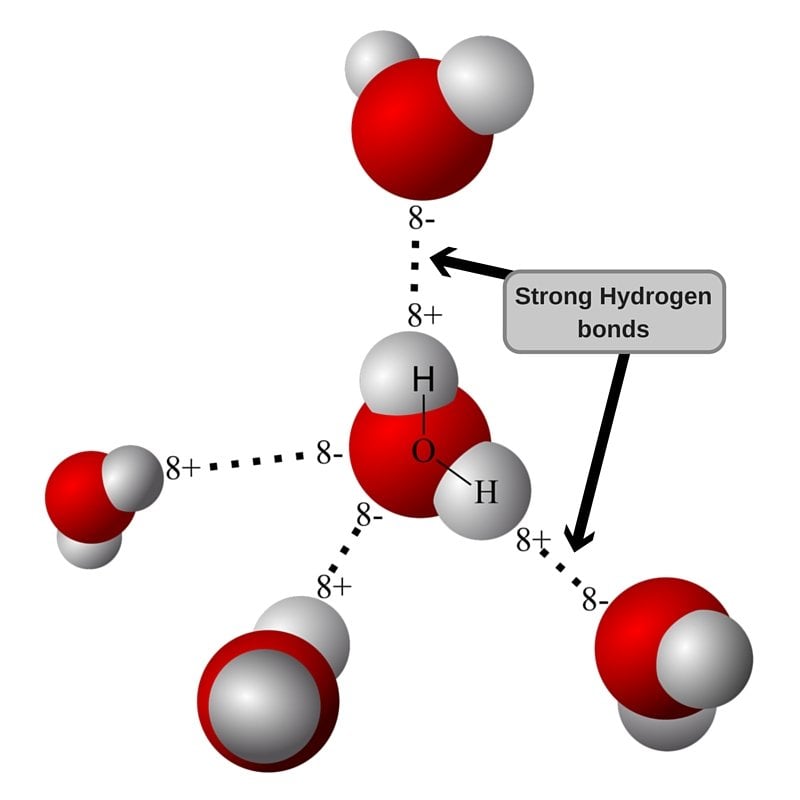Why Do Hydrogen Bonds Form Between Water Molecules
Why Do Hydrogen Bonds Form Between Water Molecules - Web because of its polarity and ability to form hydrogen bonds, water makes an excellent solvent, meaning that it can dissolve many different kinds of molecules. The image above depicts water molecules. Because of the attraction, the water molecules can pull the solute molecules apart so that the solute dissolves in the water. Web a water molecule consists of two hydrogen atoms bonded to an oxygen atom, and its overall structure is bent. Web a hydrogen bond is usually indicated by a dotted line between the hydrogen atom attached to o, n, or f (the hydrogen bond donor) and the atom that has the lone pair of electrons (the hydrogen bond acceptor). Web no, because the water can only rise as long as the adhesive forces are stronger than the force of gravity. Due to the electronegativity difference between the atom pairs mentioned, electrons are unevenly shared across the covalent bond. Once the force of gravity is equal to the adhesive forces (which vary from substance to another, according to the degree of polarity) between the water molecules and the substance's, the water will cease to rise. This is because the oxygen atom, in addition to forming bonds with the hydrogen atoms, also carries two pairs of unshared electrons. Most of the chemical reactions important to life take place in a watery environment inside of cells, and water's capacity to dissolve a wide variety of molecules is key in allowing these.
Once the force of gravity is equal to the adhesive forces (which vary from substance to another, according to the degree of polarity) between the water molecules and the substance's, the water will cease to rise. Web a water molecule consists of two hydrogen atoms bonded to an oxygen atom, and its overall structure is bent. Most of the chemical reactions important to life take place in a watery environment inside of cells, and water's capacity to dissolve a wide variety of molecules is key in allowing these. The image above depicts water molecules. Web no, because the water can only rise as long as the adhesive forces are stronger than the force of gravity. Web about transcript water is made up of two hydrogens and one oxygen atom, arranged in a tetrahedral shape. Intermolecular forces (imfs) occur between molecules. Because of the attraction, the water molecules can pull the solute molecules apart so that the solute dissolves in the water. Oxygen is highly electronegative, which creates a partial negative charge on one end of the molecule, and a partial positive charge on the other. This is because the oxygen atom, in addition to forming bonds with the hydrogen atoms, also carries two pairs of unshared electrons.
The image above depicts water molecules. Because of the attraction, the water molecules can pull the solute molecules apart so that the solute dissolves in the water. Web 1 answer evan holbrook jun 21, 2018 due to the large difference in electronegativity between oxygen and hydrogen atoms. Because each water molecule contains two hydrogen atoms and two lone pairs, a tetrahedral arrangement maximizes the number. Intermolecular forces (imfs) occur between molecules. Oxygen is highly electronegative, which creates a partial negative charge on one end of the molecule, and a partial positive charge on the other. Web no, because the water can only rise as long as the adhesive forces are stronger than the force of gravity. Web about transcript water is made up of two hydrogens and one oxygen atom, arranged in a tetrahedral shape. This is because the oxygen atom, in addition to forming bonds with the hydrogen atoms, also carries two pairs of unshared electrons. Since oxygen is so much more electronegative than hydrogen, this means that it will have a much stronger influence over electrons when bonded (it's an electron hog).
Water Review
Once the force of gravity is equal to the adhesive forces (which vary from substance to another, according to the degree of polarity) between the water molecules and the substance's, the water will cease to rise. Web no, because the water can only rise as long as the adhesive forces are stronger than the force of gravity. Web because of.
PPT Water Chemistry & Properties of Water PowerPoint Presentation
The image above depicts water molecules. Web in water, each hydrogen nucleus is covalently bound to the central oxygen atom by a pair of electrons that are shared between them. This is because the oxygen atom, in addition to forming bonds with the hydrogen atoms, also carries two pairs of unshared electrons. Web because the water molecules are small, many.
High Specific Heat (Water) — Properties & Examples Expii
Web a hydrogen bond is usually indicated by a dotted line between the hydrogen atom attached to o, n, or f (the hydrogen bond donor) and the atom that has the lone pair of electrons (the hydrogen bond acceptor). Web a water molecule consists of two hydrogen atoms bonded to an oxygen atom, and its overall structure is bent. Because.
Primary and Secondary Bonds Owlcation
Once the force of gravity is equal to the adhesive forces (which vary from substance to another, according to the degree of polarity) between the water molecules and the substance's, the water will cease to rise. Web because of its polarity and ability to form hydrogen bonds, water makes an excellent solvent, meaning that it can dissolve many different kinds.
Structure of water and ice Biology Forums Gallery Hydrogen bond
Web a hydrogen bond is usually indicated by a dotted line between the hydrogen atom attached to o, n, or f (the hydrogen bond donor) and the atom that has the lone pair of electrons (the hydrogen bond acceptor). The image above depicts water molecules. Due to the electronegativity difference between the atom pairs mentioned, electrons are unevenly shared across.
PPT Chapter 6 and 7 PowerPoint Presentation, free download ID1957632
The image above depicts water molecules. Oxygen is highly electronegative, which creates a partial negative charge on one end of the molecule, and a partial positive charge on the other. Web in water, each hydrogen nucleus is covalently bound to the central oxygen atom by a pair of electrons that are shared between them. Web because of its polarity and.
Pin on Hydrogen
Due to the electronegativity difference between the atom pairs mentioned, electrons are unevenly shared across the covalent bond. Most of the chemical reactions important to life take place in a watery environment inside of cells, and water's capacity to dissolve a wide variety of molecules is key in allowing these. Web in water, each hydrogen nucleus is covalently bound to.
Difference Between Intermolecular and Intramolecular Hydrogen Bonding
Web a hydrogen bond is usually indicated by a dotted line between the hydrogen atom attached to o, n, or f (the hydrogen bond donor) and the atom that has the lone pair of electrons (the hydrogen bond acceptor). Once the force of gravity is equal to the adhesive forces (which vary from substance to another, according to the degree.
The Unique Properties Of Water How Hydrogen Bonding Affects Our Body
Oxygen is highly electronegative, which creates a partial negative charge on one end of the molecule, and a partial positive charge on the other. The image above depicts water molecules. Most of the chemical reactions important to life take place in a watery environment inside of cells, and water's capacity to dissolve a wide variety of molecules is key in.
Why Do Fingers/Hands Stick To Ice? » Science ABC
Most of the chemical reactions important to life take place in a watery environment inside of cells, and water's capacity to dissolve a wide variety of molecules is key in allowing these. The image above depicts water molecules. Web because of its polarity and ability to form hydrogen bonds, water makes an excellent solvent, meaning that it can dissolve many.
The Image Above Depicts Water Molecules.
Web in water, each hydrogen nucleus is covalently bound to the central oxygen atom by a pair of electrons that are shared between them. Web no, because the water can only rise as long as the adhesive forces are stronger than the force of gravity. Web because of its polarity and ability to form hydrogen bonds, water makes an excellent solvent, meaning that it can dissolve many different kinds of molecules. Intermolecular forces (imfs) occur between molecules.
Oxygen Is Highly Electronegative, Which Creates A Partial Negative Charge On One End Of The Molecule, And A Partial Positive Charge On The Other.
Web a water molecule consists of two hydrogen atoms bonded to an oxygen atom, and its overall structure is bent. Since oxygen is so much more electronegative than hydrogen, this means that it will have a much stronger influence over electrons when bonded (it's an electron hog). All of the electron pairs—shared and unshared—repel each other. Web 1 answer evan holbrook jun 21, 2018 due to the large difference in electronegativity between oxygen and hydrogen atoms.
Because Of The Attraction, The Water Molecules Can Pull The Solute Molecules Apart So That The Solute Dissolves In The Water.
Once the force of gravity is equal to the adhesive forces (which vary from substance to another, according to the degree of polarity) between the water molecules and the substance's, the water will cease to rise. Due to the electronegativity difference between the atom pairs mentioned, electrons are unevenly shared across the covalent bond. Web a hydrogen bond is usually indicated by a dotted line between the hydrogen atom attached to o, n, or f (the hydrogen bond donor) and the atom that has the lone pair of electrons (the hydrogen bond acceptor). Web about transcript water is made up of two hydrogens and one oxygen atom, arranged in a tetrahedral shape.
Most Of The Chemical Reactions Important To Life Take Place In A Watery Environment Inside Of Cells, And Water's Capacity To Dissolve A Wide Variety Of Molecules Is Key In Allowing These.
Web because the water molecules are small, many of them can surround one molecule of the solute and form hydrogen bonds. Because each water molecule contains two hydrogen atoms and two lone pairs, a tetrahedral arrangement maximizes the number. This is because the oxygen atom, in addition to forming bonds with the hydrogen atoms, also carries two pairs of unshared electrons.









